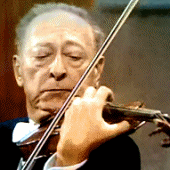![]()
|
RENOWNED VIOLINIST JASCHA HEIFETZ DIES Washington Post (c) 1995 Washington Post. All rts. reserv. OBITUARIES - Renowned Violinist Jascha Heifetz Dies. The Washington Post, December 12, 1987, By: J.Y. Smith, Washington Post Staff Writer. Jascha Heifetz, 86, one of the great violinists of this century and an artist whose marvelous talent was evident even in his early appearances as a child prodigy, died Thursday at Cedars-Sinai Medical Center in Los Angeles. Hospitalized since Oct. 16 for treatment of injuries received in a fall in his home in Beverly Hills, he had undergone brain surgery. The immediate cause of death was not reported. In a remark that was typical of the tributes elicited by Mr. Heifetz's passing, Sir Yehudi Menuhin, the London conductor and violinist, said: "Few people would disagree that he was probably the greatest violinist in our age. I would like to say that he was my greatest inspiration. I used to have all his recordings and I tried to emulate him." Mr. Heifetz was born in Vilna, Lithuania, then part of the Russian Empire. When he was 3, his father, a musician, began to teach him the violin. He first played in public when he was 4 and when he was 6 he played the Mendelssohn Violin Concerto at Kovno. When he was 10 he made his debut in St. Petersburg and the following year he played the Tchaikovsky Violin Concerto with the Berlin Philharmonic Orchestra. Appearances in Austria and Scandinavia followed. With the onset of the Russian Revolution in 1917, Mr. Heifetz came to this country. Despite his youth and the disruptions of World War I, his reputation as a major new force in music had preceded him. On Oct. 17, 1917, he made his debut at Carnegie Hall in New York. His performance that night exceeded the advance notices. Critics compared him to Fritz Kreisler, the leading virtuoso of the day, and to Nicolo Paganini, the legendary Italian violinist and composer of earlier times. Pitts Sanborn described him as "a modern miracle." Sigmund Spaeth wrote that "a tall Russian being with a mop of curly hair walked out on the stage of Carnegie Hall and made the ideal a reality." A third critic said, "The newcomer plays with a tone so tragical, so intoxicatingly sweet, that only the molten gold of Fritz Kreisler can be conjured in comparison." The debut was the occasion of one of the well-loved stories of musical legend. Among the audience were the violinist Mischa Elman, himself a prodigy as a child, and the pianist Leopold Godowski. As the performance continued and the ovations increased, Elman became visibly uneasy. At length he turned to Godowski and said, "It's hot in here, isn't it? To which Godowski replied, "Not for pianists." Mr. Heifetz soon was able to command $2,250 a performance, a figure that made him the highest paid violinist in the world up to that time. For the next half century he appeared in concert regularly in this country and elsewhere. Often he played under trying circumstances. He was in Ireland during the Sinn Fein uprisings in the early 1920s; in Japan during the earthquake of 1923; in Bombay two days after Mahatma Gandhi, the saintly leader of the Indian independence movement, had been arrested, and in Tientsin, China, in 1931 at the time the Japanese invaded Manchuria. He also played in Latin America and Australia and in 1934 he made a sentimental journey back to Russia. During World War II he played for American troops in war zones. Mr. Heifetz made numerous recordings and many of them remain available. In 1975, in fact, there appeared a six-volume anthology of various works he had recorded since first coming to this country. He frequently played chamber music, often with the great cellist Gregor Piatigorsky and Artur Rubinstein, the legendary pianist. As interested in modern music as he was in the classics, Mr. Heifetz commissioned works by contemporary composers, including William Walton, Mario Castelnuovo-Tedesco and Louis Gruenberg. He transcribed a number of pieces for the violin, the best known of which is "Hora Staccato" by the Romanian composer Grigoras Dinicu. He made four films in Hollywood. Under the pseudonym Jim Hoyle, he published several popular songs. One of them, "When You Make Love to Me (Don't Make Believe)," was a hit in 1946. He liked jazz and included his own arrangement of George Gershwin's "It Ain't Necessarily So" on some of his concert programs, including a memorable performance which was filmed for television in 1971. He detested rock 'n' roll, asserting that "its chief quality is noise." Although he had not performed in public since the early 1970s, Mr. Heifetz continued a full teaching schedule until quite recently. He taught a master's class through the Extension Division of the University of California at Los Angeles and he also taught at the University of Southern California. Teaching, he said, was a duty. "My old professor put his finger on me," he said. "He said that some day I would be good enough to teach. Violin playing is a perishable art. It must be passed on as a personal skill. Otherwise it is lost." As long as he played in public Mr. Heifetz, unlike some other great performers, remained the master of his instrument and his music, apparently immune to the infirmities of age. |
|






